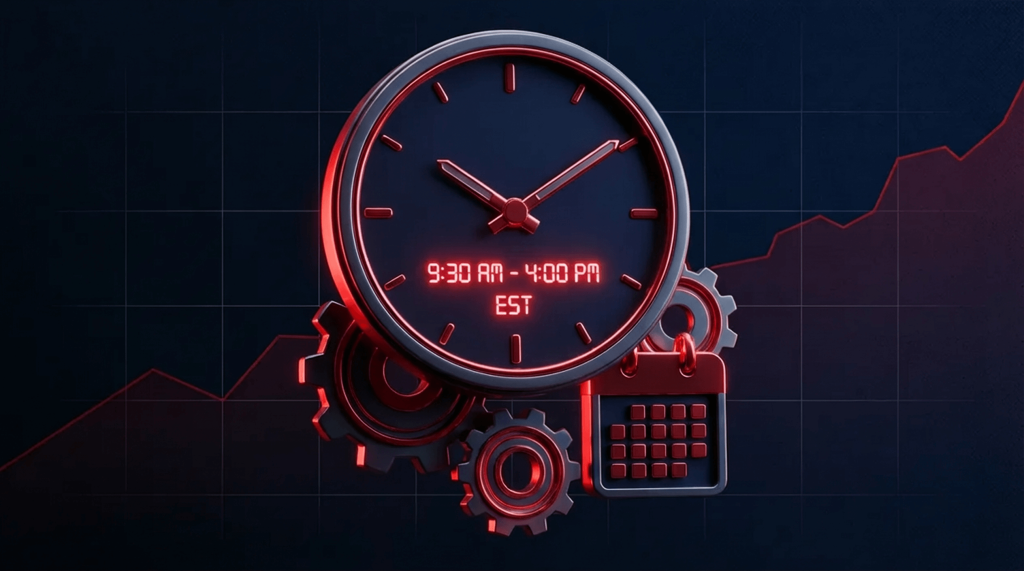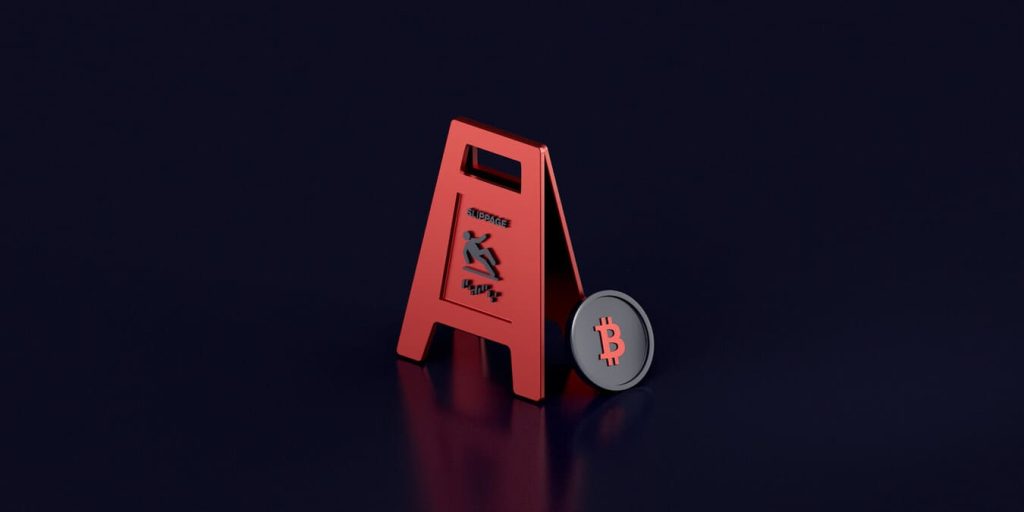
Что такое проскальзывание в трейдинге?
В статье
Проскальзывание возникает, когда сделка на финансовом рынке — с акциями, валютой, сырьевыми товарами или другими активами — совершается по цене, отличной от ожидаемой. Проскальзывание — это разница между ожидаемой ценой и ценой, по которой была совершена сделка. В случае проскальзывания трейдерам следует изучить определённые методы минимизации убытков, такие как использование лимитных ордеров, и усовершенствовать свою торговую стратегию, выбрав оптимальные торговые часы.
Глубокое погружение в проскальзывание
Прежде чем по-настоящему оценить его влияние на торговлю, необходимо понять, что такое проскальзывание и как оно проявляется на финансовых рынках. Хотя проскальзывание происходит постоянно, оно может несколько различаться в зависимости от рынка и выдаваемых ордеров.
Проскальзывание можно определить как разницу между ценой исполнения сделки и ценой, по которой трейдер ожидал её исполнения. Разница возникает именно во время исполнения ордера. На быстро меняющихся рынках цены могут колебаться в пределах этого короткого временного интервала, поэтому окончательная цена исполнения может отличаться от первоначально установленной.
Положительное проскальзывание возникает, когда сделка оказывается по более выгодной цене, чем ожидалось. Это хорошо для ваших инвестиций, поскольку означает, что вы тратите меньше, чем предполагали, при покупке чего-либо, или зарабатываете больше, чем ожидалось, при продаже.
Отрицательное проскальзывание возникает в результате сделки, совершенной по цене ниже желаемой. В этом случае вы либо получаете меньше, чем ожидали, при продаже, либо тратите больше, чем ожидали, при покупке. Это может снизить вашу прибыль от сделки.
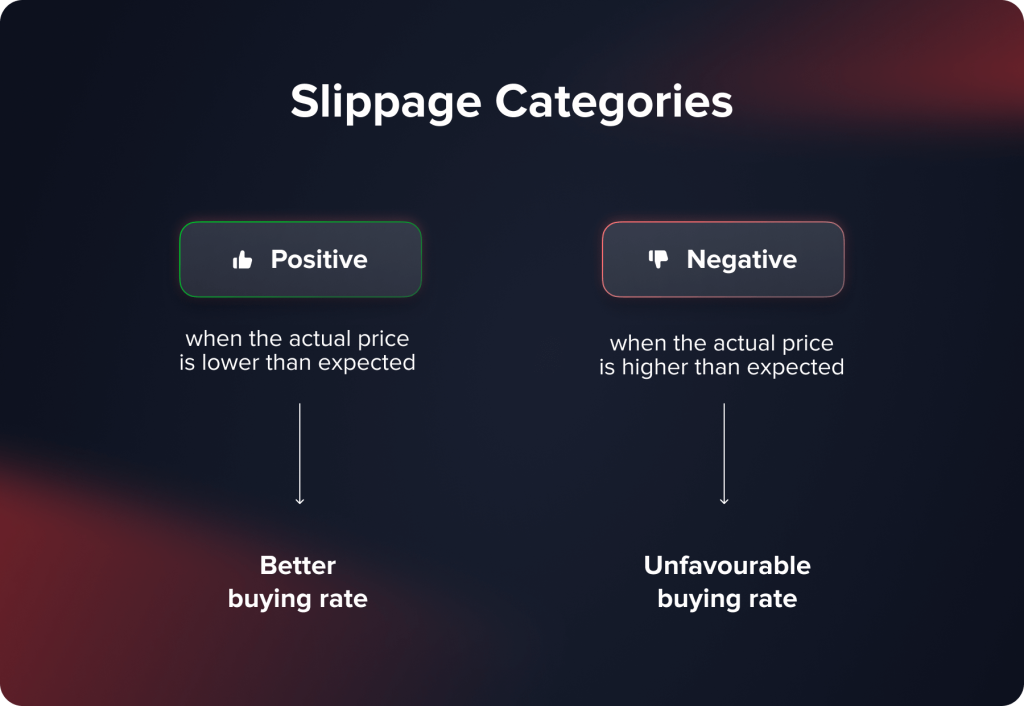
Проскальзывание на волатильных рынках
Волатильность и проскальзывание неразделимы. Колебания цен становятся более заметными по мере роста волатильности рынка. Это может быть обусловлено реакцией рынка на экономические данные, мировые события или эмоциональные перепады. Резкие колебания цен на сырьевые товары, возникающие в результате этого, делают проскальзывание более вероятным и более выраженным. В некоторых случаях цена исполнения может значительно отличаться от ожидаемой трейдерами, что затрудняет открытие и закрытие позиций.
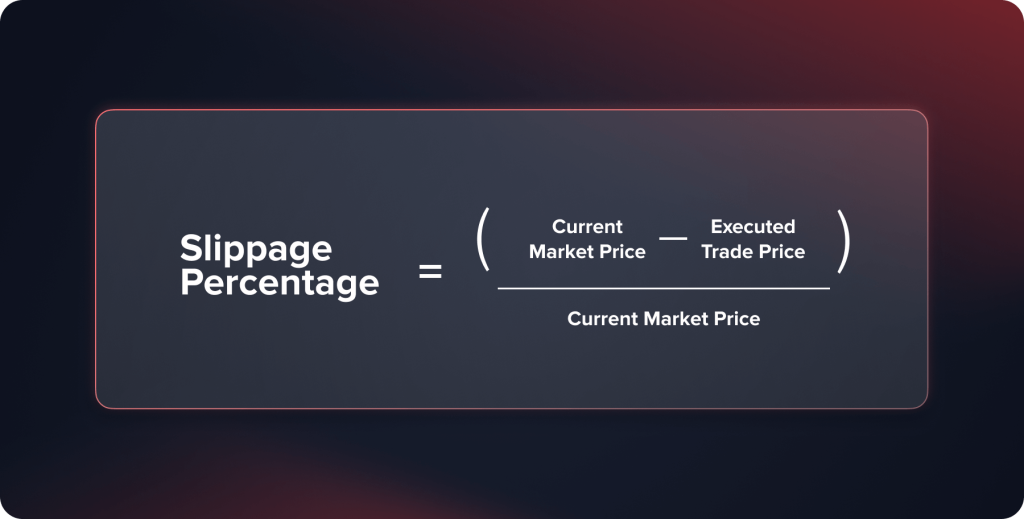
Колебания цен также способствуют проскальзыванию. Рынки — это динамичная среда, в которой на цены активов постоянно влияет ряд переменных. Эта текучесть подразумевает, что проскальзывание всегда возможно, даже в менее волатильных ситуациях, поскольку рыночная цена на момент исполнения ордера может отличаться от цены, которую трейдер видел при размещении ордера.
Проскальзывание — это нормальная часть торговли, которая может быть сопряжена с рисками и возможностями. Трейдерам необходимо понимать, как это работает, поскольку оно влияет на их решения и эффективность их торговых методов в целом. Теперь давайте рассмотрим причины проскальзывания и то, как покупатели могут с ним бороться в различных рыночных ситуациях.
Причины проскальзывания
Знание причин проскальзывания крайне важно для трейдеров, поскольку позволяет им находить стратегии, позволяющие минимизировать или ограничить его последствия. Проскальзывание может быть вызвано различными факторами, каждый из которых по-своему влияет на конечную цену сделки.
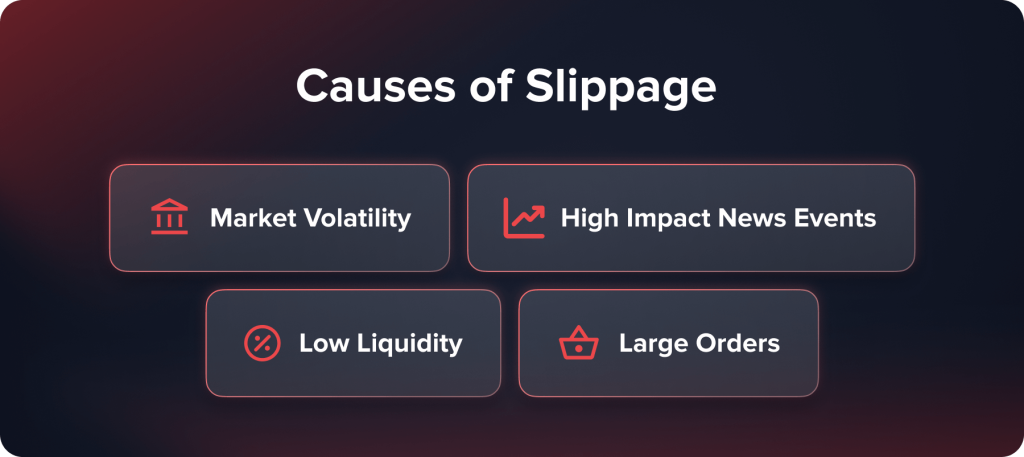
Волатильность рынка
Это относится к степени и частоте колебаний цен на финансовом рынке. На высоковолатильных рынках цены могут меняться резко и быстро за короткие промежутки времени. Основная причина экстремального проскальзывания — эти быстрые колебания. Например, цена акции или валютной пары может значительно варьироваться между моментом выдачи и исполнения торгового ордера в периоды волатильности, что приводит к заметной разнице между прогнозируемой и фактической ценой исполнения.
Важные новостные события
Рынок может быстро и драматично реагировать на события, оказывающие на него существенное влияние, такие как публикация экономической статистики, политические новости или отчёты о доходах компаний. Поскольку рынок реагирует и подстраивается под новую информацию, трейдеры часто несут убытки в эти периоды. Например, стоимость валюты может резко вырасти, если важный экономический отчёт показывает, что фактические экономические условия оказались сильнее ожидаемых. Это может повлиять на уже исполняемые ордера на Форекс.
Низкая ликвидность
Возможность быстро и легко покупать и продавать рыночные активы без существенного изменения цены называется ликвидностью. Ограниченное количество участников рынка может затруднять обработку крупных ордеров без влияния на цены активов или рынков с низкой ликвидностью. Проскальзывание происходит, когда торговый ордер размещен, но предполагаемая цена исполнения не вызывает достаточного интереса к покупке или продаже, в результате чего сделка завершается по другой цене. Например, на фондовом рынке с низкой активностью торгов даже относительно небольшой ордер может оказать значительное влияние на цену.
Крупные заказы
Размер ордера также может влиять на вероятность и степень проскальзывания. Крупные ордера, особенно на рынках с ограниченной ликвидностью, могут поглотить все доступные ордера по желаемому трейдером уровню цены, поэтому ордер исполняется по другой цене. Проскальзывание, например, может возникнуть, если трейдер заказывает крупную покупку на рынке, где нет достаточного спроса на продажу по текущей цене. Ордер может быть исполнен по более высокой цене. Этот эффект легче увидеть на рынках, где крупные ордера составляют значительную часть обычного торгового потока.
Понимание взаимосвязи между рыночной волатильностью, новостными событиями, ликвидностью и размером ордера критически важно для разработки эффективных решений для борьбы с этим явлением. Опираясь на эту основу, мы рассмотрим различные эффекты проскальзывания на разных рынках, предлагая понимание того, как трейдеры в разных обстоятельствах воспринимают проскальзывание и реагируют на него.
Проскальзывание на разных рынках
Хотя проскальзывание является естественным аспектом торговли, оно проявляется по-разному на разных рынках, поскольку каждый из них функционирует и действует по-разному. В периоды высокой волатильности и важных финансовых новостей проскальзывание очень распространено на фондовых рынках. Оно, как правило, сильнее всего затрагивает акции с меньшей рыночной капитализацией или низкими торговыми курсами. В этом случае разница между прогнозируемой и фактической ценой может увеличиться, особенно в моменты открытия и закрытия рынка.
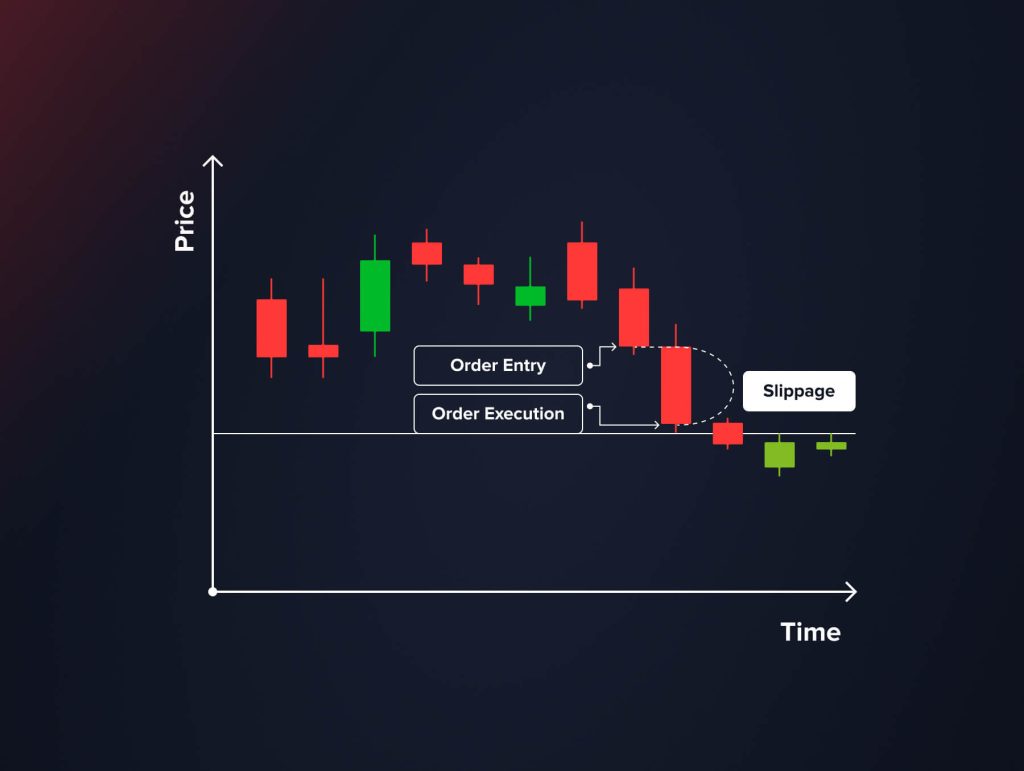
На валютном рынке, известном своей высокой ликвидностью и низкой волатильностью, проскальзывание обычно меньше. Однако во время важных экономических событий или выхода новостей даже на этом рынке может наблюдаться резкий рост цен, что приводит к проскальзыванию. В такие периоды форекс-трейдерам следует проявлять большую осторожность, чтобы ограничить риски резких колебаний цен.
Криптовалютные рынки, как правило, испытывают нехватку ликвидности и отличаются некоторой неустойчивостью. Поэтому цены могут значительно колебаться, особенно на новые валюты или в ответ на важные события, влияющие на криптоиндустрию. Поскольку эти рынки динамичны, точки входа и выхода необходимо тщательно продумывать, чтобы снизить риск проскальзывания.
Трейдерам необходимо знать, как происходит проскальзывание на этих различных рынках и что его вызывает, например, объем рынка, размер ордера и время появления новостей, чтобы хорошо планировать и избегать слишком больших потерь денег или роста издержек из-за изменения цен.
Влияние проскальзывания на трейдеров
Проскальзывание может оказывать существенное влияние на трейдеров, изменяя как результаты отдельных сделок, так и общие стратегии, которые они используют. Это влияние может проявляться как негативно, так и позитивно, в зависимости от направления проскальзывания и рыночных условий.
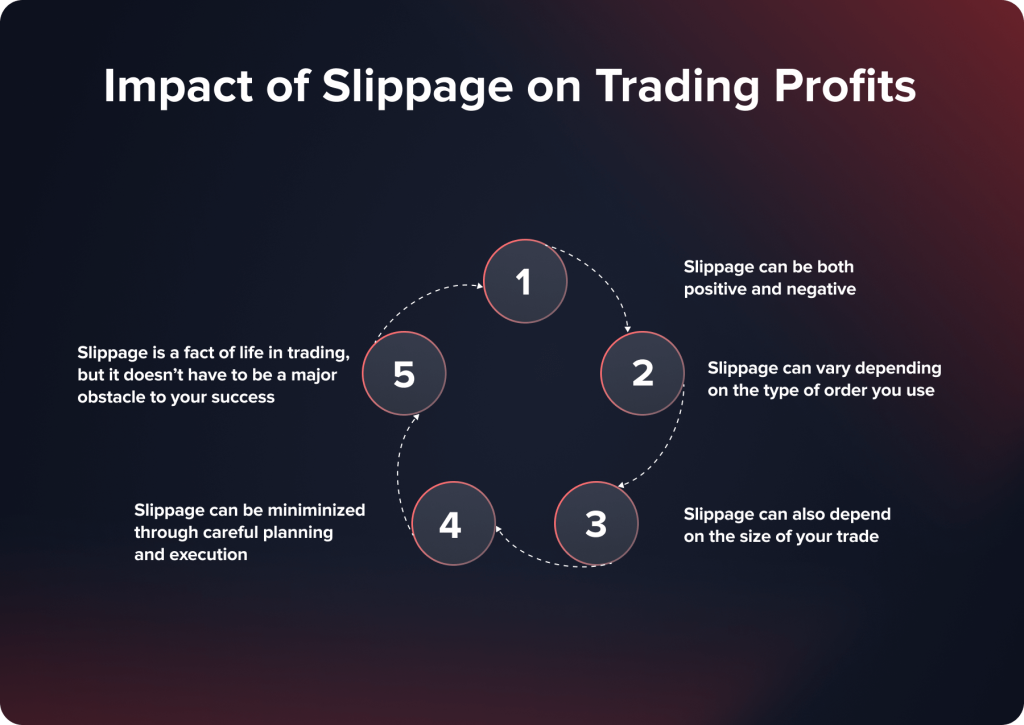
Негативные последствия проскальзывания
Одна из главных проблем, с которыми сталкиваются трейдеры, связанная с проскальзыванием, заключается в том, что оно может привести к неожиданным убыткам. Обычно это происходит, когда рынок быстро движется против желаемого продавцом направления. Например, если цена значительно вырастет до исполнения ордера трейдера, им, возможно, придётся заплатить больше, чем предполагалось. Для трейдеров, работающих на волатильных рынках с частыми колебаниями цен, это особенно сложно.
Проскальзывание иногда может сбивать трейдеров с запланированных торговых стратегий. После тщательного исследования и прогнозирования рынка трейдеры могут определить конкретные точки входа и выхода. Однако проскальзывание может изменить тщательно продуманные стратегии и вынудить трейдеров открывать и закрывать сделки по ценам, далеким от идеальных. Для таких тактик, как скальпинг, которые основаны на кратковременных корректировках цен для получения прибыли, это нарушение может иметь крайне негативные последствия.
Положительные последствия проскальзывания
Хотя большинство людей считают проскальзывание негативным событием, иногда оно может приносить неожиданную выгоду. Положительное проскальзывание возникает, когда цена исполнения сделки превышает ожидаемую. Если рынок перейдет в пользу трейдера в течение короткого периода между размещением и исполнением ордера, ордер на продажу может быть исполнен по более высокой цене. Хотя такое событие случается нечасто, оно может принести покупателям прибыль, превышающую ожидаемую.
Положительное проскальзывание часто зависит от рыночной конъюнктуры и типов используемых ордеров. Например, на рынках с высокой активностью и быстрым исполнением ордеров потенциал положительного проскальзывания может быть выше. Это особенно актуально, если трейдеры используют лимитные ордера для установки минимальной цены, которую они готовы принять.
Стратегии минимизации проскальзывания
Эффективная торговля требует тщательного контроля и максимального снижения проскальзывания. Трейдеры используют целый ряд стратегий, чтобы смягчить негативное влияние проскальзывания на свои транзакции.
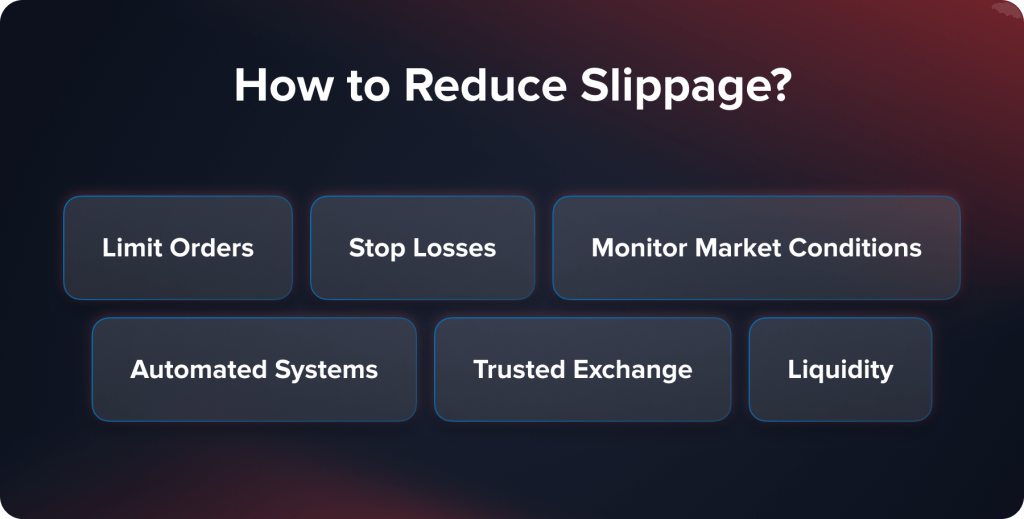
Торговля на высоколиквидных рынках
Торговля на высоколиквидных рынках — эффективный способ снизить проскальзывание. На высоколиквидных рынках часто присутствует большое количество покупателей и продавцов. Благодаря этому сделки могут заключаться быстро и, скорее всего, по желаемой цене. Основные валютные пары на рынке Форекс, такие как EUR/USD или USD/JPY, часто характеризуются высоким объёмом транзакций, что снижает вероятность существенного проскальзывания. Как правило, трейдеры фондового рынка интересуются акциями «голубых фишек», которые более ликвидны, чем акции компаний с меньшей капитализацией.
Использование лимитных ордеров
Ещё один отличный способ минимизировать проскальзывание — использовать лимитные ордера. Используя лимитный ордер, продавцы, по-видимому, указывают минимальную цену, которую они готовы принять при продаже, или максимальную цену, которую они готовы заплатить за что-либо. Это гарантирует, что сделка состоится только на уровне, удобном для продавца. Это защищает от ошибок и резких изменений на рынке. Вы можете упустить сделку, если рынок не достигнет установленной вами цены, но у вас больше контроля над ценой исполнения сделки, что делает этот способ эффективным средством управления риском проскальзывания.
Избегание торговли во время выхода важных новостей
Важные экономические и новостные события могут сделать рынок очень волатильным и увеличить убытки. Воздержание от торговли в эти периоды помогает трейдерам снизить риск потерь. Планируя сделки в период публикации важных экономических данных, заявлений центральных банков или политических событий, трейдеры могут избегать периодов, когда рынки наиболее склонны к росту или падению. Чтобы эта стратегия работала, необходимо следить за финансовым календарем и знать, когда планируются подобные новостные события.
Применение этих тактик может помочь трейдерам ориентироваться в сложной работе различных рынков и минимизировать влияние проскальзывания на свои транзакции. Хотя полностью устранить проскальзывание сложно, изучение способов снижения его частоты может привести к более точным и предсказуемым торговым результатам.
Заключение
Для успешной торговли на волатильных рынках акций, Форекс и криптовалют необходимо понимать и эффективно управлять проскальзыванием. В статье объясняется, что такое проскальзывание, как его избежать и почему оно возникает. Подчеркивается важность торговли на открытых рынках, использования лимитных или рыночных ордеров и внимательного отношения к новостным событиям, которые могут повлиять на рынок. Обладая этой информацией, трейдеры могут лучше понять, как работают финансовые рынки, что поможет им избегать неожиданностей и оптимизировать торговые планы. В конечном счёте, понимание проскальзывания — необходимый шаг к более разумной, эффективной и успешной торговле.
Обновлено:
18 декабря 2024 г.

